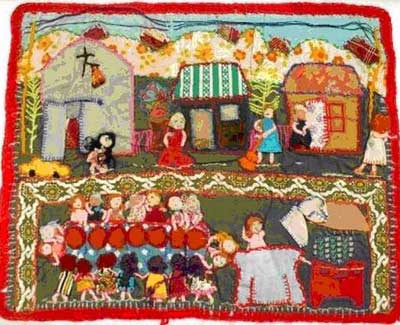Art as a tool for civil initiatives
11th September 1973 was the day Augusto Pinochet lead dramatic overthrow of the democratically elected Marxist government. More than ten thousand so called demolish citizens were gathered on the national stadium in Santiago, where many of them were publicly killed. In that time, Chile saw women as politically passive and eliminated. Dictatorship prevented women political participation outside the households, but the economic politic and political structure had an opposite effect: extreme poverty forced women to search for work and become a part of social communities with purpose of survival. That is the reason thousands of women started to participate in grassroots social movements. In that time the Catholic Church played an important role in the rebellion movement with so called Vicaria de la Solidaridad, which helped the victims of the regime. Collaborators of the movement agreed that they can help victims also with political education. One of the ways to do that was the restoration of artistic workshops for women of pueblo jovenes. On workshops women made two or three dimensional images out of textile called arpilleras.
Finished arpilleras represented the brutality of the dictatorship and living conditions. Typical arpillera showed torture on the Santiago football stadium or sea of graves marked with abbreviation N.N. (No name). Others showed disappearing symbolically: son was taken away from his mother by four black vultures (representing the leaders of the army) or a woman was dancing alone (symbolising the national dance La Cueca) without knowing the destiny of her husband. Some arpilleras represented hard everyday life – food shortage, closed factories, dictatorship. Arpilleras example represents the use of art as an alternative channel for expressing of opinion and oppositional political practice. Through them evil opponent, ethos of the movement and conditions in Chile have been shown, activation of otherwise inactive crowd was possible and strives of the movement presented. In case of arpilleras, art first had influence on micro community of the hurt women, to whom arpilleras enabled an exit out of economical straits and expression of their own opinion. Through education on workshops and spreading of information as the base for discussion about problems arpilleras had an effect on the national community and through ethos of solidarity on the international community, which supported the movement by buying arpilleras and performing the media pressure. Art has connected different layers of community, even if its first purpose was confrontational, oppositional political practice.
Art may not be grounded with purpose of integration, creation of so called public domain, strengthening and development of the society, but it has the power to do all that. Art can become a tool for achieving our purpose that indirectly creates arenas, within which opinions are expressed, developed and strengthen. In like manner, art can become a tool of distortion, manipulation, propaganda, that divides community and causes conflict. Individuals and social groups, their power and interests are the ones setting the borders. Art is just a tool, waiting to be used. Let's use it wisely.

Comments
14 years, 10 months
http://www.rebelart.net/diary/van-der-art-iii-sebastian-errazuriz-memorial-of-a-concentration-camp/005028/

To comment, please create a Memefest account, it will take you only 2 minutes! Login here if you already have one.